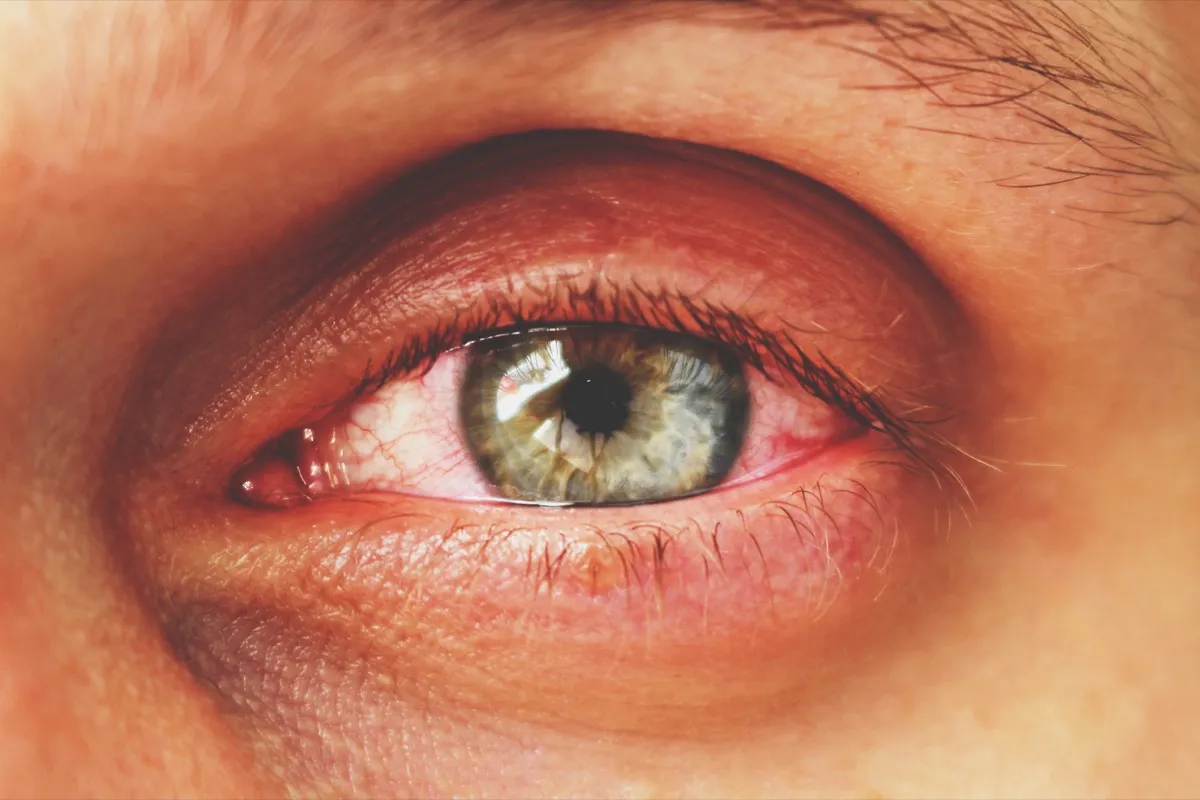Incredibly, these symptoms affect just about every part of the body and present in drastically different ways. They run the gamut from heart palpitations, to pink eye, to “COVID toes,” to a loss of taste or smell—and that’s just the beginning. Read on for the full roster of strange coronavirus symptoms that you could be ignoring. And for more coronavirus mysteries to set straight, check out 25 Coronavirus Myths You Need to Stop Believing, According to Doctors. Delirium is a common symptom among the most severe cases of COVID, especially in instances where the patient is elderly. According to The Harvard Gazette, one third of hospitalized patients, and two thirds of patients whose cases are classified as “severe,” experience delirium in the form of extreme confusion and vivid hallucinations. Though coughing is a common symptom of coronavirus, few people are aware that a percentage of COVID patients cough up blood. Though alarming, it doesn’t necessarily indicate a severe case of the virus. “Airway inflammation sometimes leads to a very fragile lining of the airways, and those small blood vessels, or capillaries, might be affected, causing blood to come out,” Anthony Rizzo, MD, chief medical officer of the American Lung Association, told Today. If you suddenly lose your sense of taste or smell, you should be tested for coronavirus, according to the Centers for Disease Control (CDC). This surprising symptom flew under the radar for the first part of the pandemic, but is now well documented and associated with milder cases of the virus. And to learn more about coronavirus symptoms, This Is How Many COVID Symptoms Most Infected People Have. If you’ve noticed painful, red sores on the tips of your toes, you may be experiencing a symptom of coronavirus commonly referred to as “COVID toes.” Perhaps one of the stranger signs of the virus, a June study in the British Journal of Dermatology showed that patients have been reporting foot sores known as chilblains with “increasing frequency.” These are caused by vascular and endothelial damage, and typically go away after two to three weeks. While COVID toes have made headlines, fewer people are aware that some patients present with similar lesions on their hands, according to a June study in the International Journal of Dermatology. However, if your hands are red or swollen, don’t panic just yet: Many people are also currently experiencing contact dermatitis—a form of skin irritation—brought on by frequent use of hand sanitizer. And for more on safe sanitizer use, check out these 6 Subtle Signs You Need to Replace Your Hand Sanitizer.ae0fcc31ae342fd3a1346ebb1f342fcb Swollen eyelids are a lesser known symptom of coronavirus. They’re featured on a broader list of eye problems that tend to be “more common in people with severe infections” of COVID, according to William F. Marshall, III, MD, an infectious disease specialist with the Mayo Clinic. Similarly, researchers have revealed that pink eye is considered just cause for a COVID test. According to an April study published in The Canadian Journal of Ophthalmology, conjunctivitis can be a primary symptom of coronavirus, in the absence of fever or respiratory symptoms. The Mayo Clinic points out that sensitivity to light is another uncommon ocular symptom that could suggest a COVID diagnosis. A March study published in JAMA Ophthalmology recently reported that this was one of several eye-related symptoms experienced by 31 percent of coronavirus patients. According to the CDC, gastrointestinal symptoms are a common yet surprising sign of coronavirus. Upset stomach and diarrhea frequently appear in milder cases, sometimes presenting as the COVID only symptom. According to an April study published in the journal Gastroenterology, 12 percent of coronavirus patients experience nausea or vomiting. The good news? Eighty nine percent of study subjects described their gastrointestinal symptoms as “mild.” For some patients, these symptoms lasted for as little as one day. And for more sneaky symptoms to add to the list, check out these 7 New Symptoms The CDC Says You Need To Look Out for in Your Kids. That same study revealed that 22 percent of patients experience a loss of appetite, and as a result, some have subsequent weight loss. And for more signs your weight loss isn’t a good thing, check out 11 Subtle Signs Your Rapid Weight Loss Is Something Serious. According to the World Health Organization (WHO), roughly 11 percent of coronavirus patients experience chills while fighting their illness. This surprising symptom is typically accompanied by a fever. Though blood clots are unfortunately considered a somewhat common symptom of severe coronavirus, they remain surprising in how widespread and aggressive they can be. Amy Rapkiewicz, MD, a pathologist from NYU Langone Medical Center, recently told CNN she found blood clots in “almost every organ” during autopsies of deceased COVID patients. A May study published in the journal Cureus showed that roughly 18 percent of coronavirus patients report myalgia—the clinical term for muscle aches or weakness—as part of their illness. While uncomfortable, this particular symptom is not statistically associated with severe cases. According to the CDC, having a runny nose or congestion can be a sneaky sign of coronavirus. This symptom is often dismissed as the common cold or seasonal allergies, making it difficult to recognize as a symptom of COVID. According to the American Heart Association, many patients experience heart palpitations during the course of their illness. Unfortunately, this coronary symptom tends to be one symptom that can remain long-term, long after other symptoms have subsided. Researchers have found one shocking and disturbing symptom of coronavirus that could put many patients at risk: “happy” hypoxia. This is when a patient’s blood oxygen levels dip dangerously low, but without the tell-tale respiratory distress that usually flags the problem. Investing in a blood oxygen monitor could save your life, in the event that you present with this sneaky symptom. Increasingly, coronavirus patients have begun reporting a “buzzing,” “tingling,” “fizzing,” or “burning” sensation in their chests. This may be the feeling of the immune system activating immune cells and releasing chemicals, Waleed Javaid, MD, director of infection prevention and control at Mount Sinai Downtown in New York, told Today. “Our immune cells get activated so a lot of chemicals get released throughout our body and that can present or feel like there’s some fizzing,” he said. Blood clots are common among coronavirus patients, and even young, otherwise healthy patients have experienced strokes as a result. In May, The New York Times reported about a “flurry of cases” in which patients suffered strokes, with few or no other symptoms at all. Dizziness is yet another surprising coronavirus sign—one that reveals the neurological effects the virus can have on the body, according to a June study in the Journal of Neurology. These dizzy spells can be severe and abrupt, in some cases causing fainting or a sensation of vertigo. And for more neurological effects of COVID, check out The Surprising Coronavirus Symptom You Haven’t Heard About. According to the same Journal of Neurology study on the neurological effects of coronavirus, 33 percent of COVID patients experience fatigue while sick. This was the most common neurological manifestation of the virus, and one that is likely compounded by other symptoms. The same study also shows that many coronavirus patients have reported feeling malaise, a general sense of discomfort or uneasiness with no clear source. Some patients whose illnesses have stretched on for months still report this feeling long after other symptoms are gone, The Washington Post reports. In the context of coronavirus, high iron levels could indicate a very dangerous immune response called a cytokine storm that can cause death in even young, otherwise healthy patients. According to a June study in the Pan American Journal of Public Health, monitoring iron levels, which can signal immune dysregulation, can tip doctors off to whether a patient is at risk of having a severe cytokine response.



